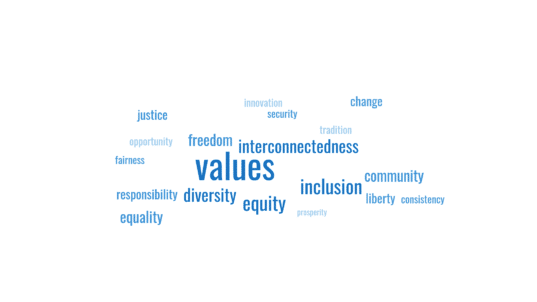Introducing the Identity Pie Activity
Dear collaborative discussion friends,
This time we are highlighting an activity that helps to build self-awareness about our social and cultural identities. It explores the meanings we ascribe to these identities and how they show up (or are hidden) in different contexts. Through discussion, participants should conclude this activity with a deeper appreciation for which parts of their identity show up more dominantly in a discussion (and why) as well as a greater awareness of how others express, hide, self-censor, or regulate their own identities in a discussion.
This activity can be found in the Culturally Responsive Collaboration Module, contributed by Richard Kiely, Senior Fellow in the Office of Engaged Initiatives at Cornell University.
If you missed the previous newsletter about Measuring Emotional Charge in Collaborative Discussion, you can access it and our other weekly newsletters by subscribing below.
This week’s activity:
Activity 4.1 – Awareness of Social Identity
How to increase awareness of and engage with identities in a discussion
Examining our ascribed and avowed identities helps us to better understand who we are and what parts of our identity we allow to show up in a discussion group. Being aware of the visible/invisible, declared/hidden components of our identity helps us to develop self awareness and greater appreciation for the complex identities of others.
Many of us are familiar with the Identity Pie activity in some form. We are going to break down this activity step-by-step so that you might use it to help discussion participants examine how social identities affect discussions.
Reflect Individually
Begin this activity by asking participants to take 5 minutes to quietly reflect and write down important aspects of their identity. Ask: What makes up you? You can offer additional prompts to help participants explore key components of their identity, for example:
- How do you describe yourself? How would others describe you?
- What visible and invisible traits are most important to you?
- Which life experiences have shaped who you are?
Encourage participants to write freely. Their notes will not be shared. Encourage them to try not to self-censor. Pro tip: you will be tempted (or asked) to offer examples. Don’t offer examples because they can limit or shape how participants respond.
Draw an Identity Pie
Next, take about 10 minutes to allow participants to create a visual representation of the top 5 – 10 attributes of their identity.
Invite them to draw a pie. Create slices for each key attribute, making the more important attributes larger slices of the pie.
Alternatively, you could ask them to pretend that they are packing a suitcase and each item they pack is a piece of their identity. Some items will take up more space than others. Draw this packed suitcase.
As they draw and reflect on their own Identity Pie or Identity Suitcase, ask some of the following prompts. Encourage participants to only share what they are comfortable sharing. These questions might spark additional insights and help them to go deeper. However, this is not the discussion component of the activity. Some participants may respond or these prompts may just intentionally linger in the air.
- Which identities do you choose to express and why?
- Which identities feel more dominant in different contexts such as work or school, at home with family, in public spaces like a restaurant, a park or on the street?
- Which identities do you think are the most visible? Which ones do you deliberately hide?
- Which identities do you feel are most accepted by your family, community or larger society? Which do you wish would be more accepted?
Share in Small Groups
Next, break into pairs or small groups. Invite participants to share their representations, but this should not be a requirement. Ask them to share whichever attributes they are most comfortable sharing with others.
Take about 10 minutes for small groups to listen to each other and ask questions to gain a deeper understanding. Some possible prompts include:
- What role does this attribute play in your life?
- What similarities or differences exist in the ways you describe and experience your identities in different contexts?
- What surprised you about what you wrote about your own identity or identities?
- What surprised you about your understanding of your partner’s identity or identities?
Before reconvening into the large group, be sure that participants ask their partners or group members if it is okay to share from their conversation when they debrief with the full group.
Discuss as a Full Group
The final step of this activity is to regroup and have each person share something they learned from their small group conversation. This could be something their partner or group member expressed really well or an aspect or identity that they realized they did not include in their identity pie after listening to others.
Have the group then explore bigger questions, such as:
- How can being aware of your own identity and viewpoint (and open to learning about others) impact how we work together?
- How does this examination of identity lead to action? For example, how might critical self-reflection challenge power imbalances in groups and advance accountability?
In addition to these debriefing questions, the full description of Activity 4.1 – Awareness of Social Identity also includes reflection questions, a practice journal prompt and additional resources to help participants dive deeper.
If you try out this activity, please share with us what you think:
We hope this toolkit activity helps participants gain a deeper understanding of themselves and others, leading to more engaged and empathic discussions. In our upcoming newsletter we will be highlighting a fun, playful activity that helps uncover our deep, dark, secret civic passions. Ooh la la. Just kidding. It’s actually a Civic Sweet Sixteen Activity for all of you who enjoy basketball or just some good old fun!
Upcoming Events
- We are accepting applications for our next Collaborative Discussion Coach Training (May 31 – June 6). This training is open to anyone interested in offering certificate programs in the future. You can apply here or share this newsletter with people you think might be interested.
- We are also accepting nominations for our Pilot Coach Training for Undergraduate Students. Space will be limited. You can learn more or nominate a student by emailing me at [email protected]
Looking forward to collaborating with you this year,
Shannon Wheatley Hartman, Ritu Thomas & the Collaborative Discussion Team





